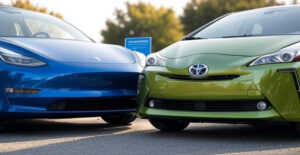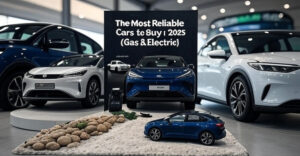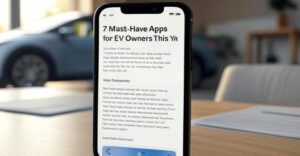Summary
Thinking about going electric in 2025? You’re not alone, mate. More and more folks are trading in their gas-guzzlers for sleek electric vehicles (EVs) every year. But here’s the kicker: they ain’t cheap. Good news is, the government’s practically throwing money at you to make the switch. From juicy federal rebates to sneaky little local incentives, you can shave thousands off that sticker price—if you know where to look. This guide spills all the beans, step-by-step, so you don’t leave a single dollar on the table. Plug in, buckle up, and let’s get you that sweet rebate cash.
Why Governments Are Giving Away Money for EVs
Governments love a good PR move. And saving the planet? Big PR win. By offering EV rebates and tax credits, they’re pushing folks to ditch fossil fuels, cut down emissions, and hit those aggressive climate goals everyone’s yappin’ about. So yeah, you buying an electric car is basically a favor to them—one they’ll gladly pay for.
Federal EV Rebates: The Big Daddy of Savings
Understanding the Federal Tax Credit
In the U.S., the federal government offers up to $7,500 in tax credits when you buy a new electric vehicle. But hold up—this ain’t a check they mail you. It’s a non-refundable tax credit. That means when tax season rolls around, your tax bill could drop by up to $7,500. If you owe less than that, well, congrats, you’ll zero out your taxes, but you don’t get the leftover as cash.
Income Caps & Eligibility Rules
2025’s got some new twists. The Inflation Reduction Act added income caps—if you earn too much, you’re outta luck. For individuals, the income limit’s around $150,000; for joint filers, it’s about $300,000. Also, the car’s gotta be assembled in North America and meet battery sourcing requirements. So check the fine print before you fall in love with that flashy import.
The New Instant Rebate at the Dealership
Starting this year, you can transfer your tax credit to the dealership for an instant discount. So instead of waiting till April, you get your money off the sticker price right away. Just tell your dealer, “Hey buddy, I’m transferring my EV tax credit.” Simple as that.
State Rebates: Where the Real Fun Begins
California: Still the Golden Child for EV Incentives
California’s got its Clean Vehicle Rebate Project (CVRP). It hands out up to $2,000 extra, on top of the federal deal. Lower-income buyers? They can pocket an even fatter rebate. But funds run out quick—so apply early, or you’ll be stuck singing the blues.
New York, New Jersey, & The Northeast
New York’s Drive Clean Rebate gives up to $2,000 for eligible cars. Jersey’s Charge Up Program? Up to $4,000. These states are so eager to cut smog, they’ll practically roll out the red carpet when you show up in your new EV.
Check Your Local Programs
Don’t sleep on local utilities either. Many will toss in rebates for installing a home charger. It’s like finding a $100 bill in an old coat pocket—except it’s sometimes thousands. So before you plug in your shiny new car, ring up your power company. You might be surprised.
How to Actually Get These Rebates Without Pulling Your Hair Out
Step 1: Research, Research, Research
Before you test drive, pull up your state’s rebate programs. Each one’s got different forms, deadlines, and hoops to jump through. Bookmark those sites. Stay updated. Some rebates are first-come, first-served, and when the pot’s empty, that’s it till next year.
Step 2: Pick the Right Car
Not every EV qualifies for every incentive. Make sure your dream ride is eligible. Check its final assembly location, battery sourcing, MSRP limit (usually around $55,000 for sedans, $80,000 for SUVs/trucks).
Step 3: Gather Your Docs
You’ll need proof of purchase, residency, income (sometimes), and all the VIN numbers your brain can handle. Don’t toss that paperwork—without it, you’re waving goodbye to your rebate.
Step 4: Apply ASAP
Some rebates you apply for online, some through the dealership. For federal credits, you’ll file IRS Form 8936 with your tax return—unless you do the new instant transfer at the dealership.
Secret Perks You Might Be Missing
Utility Company Bonuses
Your local utility might pay you to charge your car at night, when the grid’s chillin’. Or they’ll give you a rebate for buying a smart charger. Imagine your power company paying you to use power. It’s wild, but it’s real.
HOV Lane Access
Some states give EV drivers special stickers to drive solo in the carpool lane. If you’re stuck in traffic every morning, this alone can save your sanity.
Free Parking & Toll Discounts
Cities like San Francisco and Los Angeles offer free or discounted parking for EVs. Same for some toll roads. Over a year? That’s a nice chunk of change.

Common Mistakes to Dodge
Buying Used—Not Always a Good Thing
Some used EVs qualify for a smaller federal credit ($4,000 max) under the new rules. But they’ve gotta be under $25,000 and meet strict requirements. Always double-check before buying second-hand.
Forgetting Deadlines
Many rebates come with a time limit. Miss it? Tough luck. Mark those dates on your calendar the minute you drive off the lot.
Ignoring Tax Situations
A tax credit only helps if you owe taxes. If your tax liability’s super low, you might not get the full $7,500. So run the numbers with your accountant first.
The Bottom Line: Is It Worth the Hassle?
Short answer—heck yeah. Done right, you can save $10,000+ when you stack federal, state, local, and utility rebates. Sure, there’s paperwork. But c’mon, you’d do more for a free pizza. Just remember: do your homework, act fast, and don’t trust that the salesperson knows every detail—many don’t.
Your EV could be saving you money before you even take it for its first spin around the block. And once you do? Well, you’re cruising on sunshine, baby.
Your EV Rebate Questions—Answered
Q1: Can I get a rebate for a leased EV?
Sometimes! Many lease deals bake the federal credit into your lease price, so you benefit indirectly.
Q2: What if my state rebate funds run out?
Tough luck till next year—apply ASAP!
Q3: Do plug-in hybrids qualify?
Yep, many do. They need a minimum battery size, so check eligibility.
Q4: Do I need a special home charger?
Not always, but a Level 2 charger’s way faster. Check if your utility rebates part of the install cost.
Q5: How long does the federal EV credit last?
It’s updated every few years. For now, the new rules go through at least 2032.
Q6: Are commercial vehicles eligible?
Yep! There’s a separate credit for businesses buying electric vans, trucks, and buses.
Q7: How do I claim the instant rebate at the dealer?
Just tell the dealer you want to transfer the credit. They handle the paperwork.
Q8: Can I get a rebate for buying a used Tesla?
If it’s under $25k, yes! But read the fine print—it must meet age and battery rules.
Q9: Do income limits apply to state rebates too?
Some states do have income caps. Always check your local program.
Q10: Can I claim the rebate twice if I buy two EVs?
One rebate per vehicle. But if you can afford two, go wild.
Q11: How do I find my local utility’s incentives?
Search “[Your utility name] EV rebates” or call ‘em. They’ve usually got a dedicated page.
Q12: Can renters get rebates for chargers?
Maybe! Some landlords or building owners work with tenants to install chargers—worth asking.








